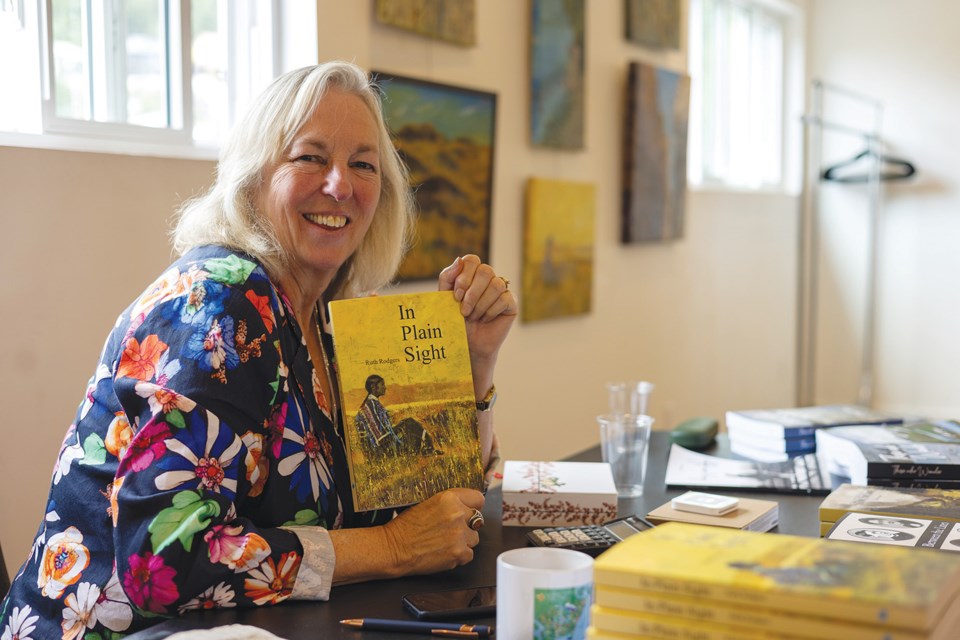The latest book by Ruth Rodgers — the seventh novel by the Coast author whose previous works illustrated the human impacts of true-life history like the Second World War internment of Japanese-Canadians — shifts the geographic focus of her fiction into southern Alberta in the late 1870s.
In Plain Sight explores an era of seismic changes in the relationship between Indigenous inhabitants and settlers of the Canadian prairies. The arrival of white settlers resulted in the near-extinction of bison, fostered the destructive influence of the American whiskey trade, introduced the Royal North-West Mounted Police to the region and prompted treaty negotiations.
It is also Rodgers’s first book to bear her own artwork (she is a prolific landscape artist and a member of the erstwhile Landing Artists Collective): her mixed-media painting Farsighted illustrates the cover of the independently published edition.
Rodgers launched the novel at a special event on Aug. 24 at the Gibsons Public Market. She discussed the impetus for the book (an online seminar on gender diversity) and her extensive research into gender diversity among the Blackfoot people. The Blackfoot citizens of her novel recognize four gender identities: man, woman, the halfman-halfwoman (“berdache”) and the manly-hearted woman. A young person’s identity is revealed during a vision quest and encounter with a spirit animal, followed by formal recognition of the new status by community members.
During a professional development seminar, Rodgers was provided with a global map with links to places where gender diversity has been an accepted or traditional part of culture. Rodgers immediately recognized storytelling potential. “Of course, I was first drawn to click on the only link located in Canada — in southern Alberta, specifically,” she recollected. “Immediately I imagined what a great storyline these [Blackfoot traditions] would make, an opportunity to explore another bit of little-known Canadian history.”
Written from the first-person perspective of an itinerant British photographer — the younger son of an earl — In Plain Sight grapples with immense social and technological change. Will Finch-Hatton first arrives in North America as a member of the Royal Engineers. His emotional connection to the prairies is born of its aesthetic appeal and its relatively ease of traversal after the extremes of Ontario: “I fell deeply in love with the prairie with its arching bowl of sky and infinite horizon, though I was aware that part of my attraction to the plains had started as simple relief.”
Finch-Hatton also develops an affinity for the Blackfoot people, and one of their women in particular: Silent Running Wolf. The two navigate the societal changes that accompany the signing of Treaties 6 and 7, which dramatically affected the course of Blackfoot future. Combined with insights into the image-shaping power of early photography, Rodgers’s narrative provides intimate glimpses of contemporary cross-cultural challenges coming into focus. Finch-Hatton’s worldview is slowly broadened through his devotion to Silent Running Wolf: “If completing these rituals gave my wife comfort and returned her confidence, I would do what I could to support her prayers.”
The book’s narrator was inspired by real-life American photographer and ethnographer Edward Curtis. “His collection is flawed by the effects of reservation life and his own European/male assumptions, yet it does serve as a precious record of our continent’s first peoples,” said Rodgers.
She selected several of Curtis’s photos that feature Blackfoot peoples and collaged copies of them onto textured acrylic backgrounds, adding colour to the black and white photos. Selections from the series can be viewed online at ruthrodgers.com.
In Plain Sight is available for sale at Talewind Books in Sechelt, Earthfair Books in Madeira Park, and from Amazon.ca.



